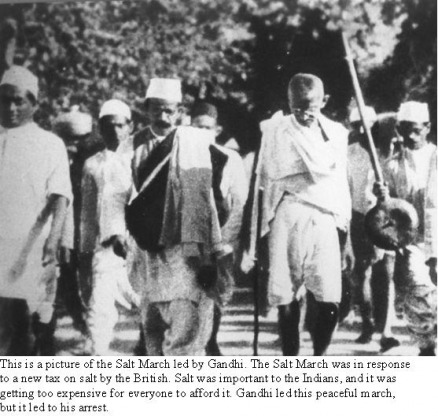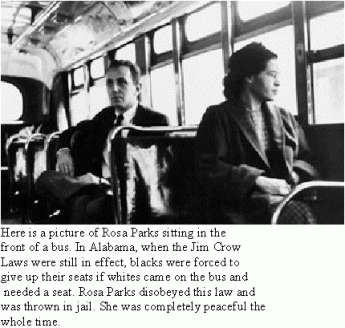Civil Disobedience

Civil disobedience can be defined as the active refusal to obey laws set by the government. Nonviolent resistance and respectful disagreement typically characterize this level of disobedience. Mohandas Gandhi was one of the first leaders to fully embrace this way of fighting for human rights. During the late 19th century and the early 20th century, Gandhi made the biggest steps towards making India an independent nation free of British control. Without using any violence, Gandhi organized and participated in many peaceful demonstrations, rallies, and boycotts. Although many powers believe force and violence are key to reaching a goal, Gandhi proved that peaceful rebellion is much more effective through protest and boycotts, which are strategies used by leaders today.

Protests can be executed in the form of marches, demonstrations, and even meetings. As a way to unite the Indian people, Gandhi organized many of these in response to the British Raj. In 1763, the British gained full control of India. Their expansion was restrained to the Ganges River. The British government chartered the British East Indies Company to control India. The British East Indies Company was given the right to tax the landowners and controlled all of India’s imports and export s. Queen Victoria took the title of Empress of India, and it was this that fueled Indian nationalism. The British treated the Indians as if they were lesser beings as a result of Social Darwinism, which also catapulted Indian nationalism. As a result of this oppression, Gandhi organized protests against the British. Gandhi organized the NIC, or Natal Indian Congress, which symbolized a resistance to British injustices. After WWI, Gandhi called his followers to meet in Amritsar in protest against a new legislation set by the British. Although the British had previously set a law preventing Indians to gather in large groups, they did it despite the law. When the British found out, they set fire and killed 400 Indian men, women, and children. The Indians did not respond violently to this massacre, and therefore the British appeared to be cruel through the eyes of the international press. Gandhi resigned from the NIC after this in fear of the lives of the Indian people. He later got involved with politics and joined the Indian National Congress. With them, he participated in the Salt March. He leadership in this protest landed him in jail. Once again, the international press made the British look bad because they arrested Gandhi for no reason but walking peacefully with a group of people. Gandhi’s strategy of peaceful rebellion was very smart. The British began to be conveyed as cruel and harsh, and this became one of the reasons that the British was forced to leave India as an independent nation.

Another form of peaceful rebellion was boycotting. In 1820, British factories began developing fine cotton cloth. They, however, did not want any competition. As a result, the Parliament passed a law that destroyed the cotton making industry in India. By 1830, India was totally incapable of exporting cloth. The British destroyed all Indian spinning wheels and arrested anyone who tried to make their own cloth. As an act of resistance, Gandhi kept his spinning wheel, made his own clothes, and refused to buy British cloth. He encouraged many Indians to do the same. Gandhi was arrested on the charge of making his own cloth. Once again, the British were deemed cruel and unintelligent to the rest of the world through the international press. Gandhi often invited the press to watch his demonstrations, which was key to his plan of Indian independence. By boycotting many other British goods as well, the Indians were able to gradually force the British out of India. The British eventually realized that the Indian resistance was making their business and political intent unprofitable so as a result they left. Without using the tactic of bloodshed, the Indians were able to achieve the independence they yearned for. Peaceful rebellion through boycott proved to be the best way to meet their nationalist goals.

Today, many leaders look to Gandhi as an inspiration. His peaceful ways and tolerating views inspire many people to resist violence when fighting for what they believe. Martin Luther King Jr. is a prime example of a leader who followed Gandhi’s strategy of civil disobedience. Martin Luther King Jr. was a black man during the Civil Rights Movement of the 1950s-60s. He too organized protests and boycotts in resistance to the government. At that time, the government had many laws pertaining to the segregation of blacks and whites. Martin Luther King Jr. challenged Black Americans to not observe the segregation laws. A prime example of this peaceful rebellion would be that carried out by the black woman, Rosa Parks. The United States had a law stating that white Americans had the right to sit in the front of the bus and the black Americans had sit in the back and give up their seats if a white person wanted their seat. When Rosa Parks got on the bus, she made the brave decision to sit in the front and refused to give up her seat. The police were soon called, and Parks was arrested. Acts like this paved the way for full equality between blacks and whites. Like many situations that Gandhi was involved in, the press gave the incident a lot of attention, conveying American law negatively. Also like Gandhi, many leaders use the media to spread their ideas. There was a lot of media coverage during the Civil Rights Movement, and this definitely helped people hear the arguments of all sides. Gandhi’s strategy of peaceful and nonviolent resistance to existing unjust laws is an excellent role model to follow when a group demands change.
Thus, although many powers still believe violence is most often necessary to prove a point, Gandhi showed beyond doubt that peaceful rebellion is in many ways as effective through protest and boycotts, and he has influenced many leaders of today. Even though it is difficult not to fight back when attacked, the peaceful person always comes out as the winner. If the leading powers of the world today followed Gandhi’s principal, the world would be a much safer place. Protest, boycott, and peaceful demonstrations are key to proving a strong point without any bloodshed. Civil disobedience can be economically and socially challenging to the group fighting for change, but their sacrifices often lead to a long-term, much needed change.
-Camille Bergsrud
Bibliography
McGraw-Hill. Glencoe World History, Student Edition.New York: Glencoe/
McGraw-Hill, 2007.
'Mohandas Gandhi.' World History: The ModernEra. 2009. ABC-CLIO. 4 Apr. 2009
Timeline
- 1763: The British gained full control of India, and Queen Victoria became of the Empress of India.
- 1820: The British factories began to develop fine cotton cloth.
- 1830: The British took away the Indian’s right to make their own cloth, and made India totally incapable of exporting cloth.
- 1919: Over 400 men, women, and children were killed while gathered at an illegal meeting in Amritsar.
- 1920-1922: Gandhi encouraged the Indians to participate in the Noncooperation Movement to protest against the British Raj.
- 1930: Gandhi led the Salt March against the British tax on salt, which led to his arrest.
- 1955: Rosa Parks refused to give up her seat to a white man on a bus in Alabama.
